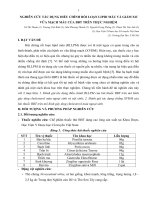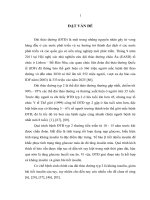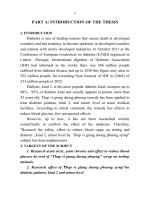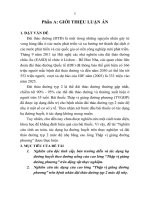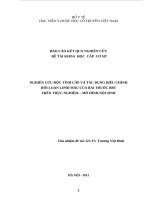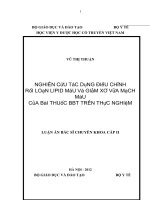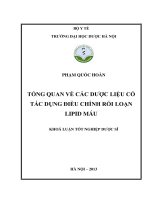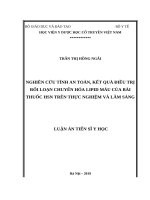Nghiên cứu tính an toàn, tác dụng điều chỉnh rối loạn lipid máu trên thực nghiệm và lâm sàng của cốm hạ mỡ máu tt tiếng anh
Bạn đang xem bản rút gọn của tài liệu. Xem và tải ngay bản đầy đủ của tài liệu tại đây (386.32 KB, 26 trang )
1
INTRODUCTION
In recent years, along with the development of economy, social
life, the diet has become increasingly rich and unreasonable, causing
an increase in dyslipidemia. Regardless the fact that it is not an acute
disease, dyslipidemia is one of the leading risk factors which cause
formation and development of atherosclerosis. In Vietnam,
atherosclerotic disease with clinical manifestations such as coronary
insufficiency, myocardial infarction, cerebral vascular accident, etc.
currently tends to increase rapidly according to the pace of social
development. With modern equipment, researchers have proved that
treating dyslipidemia is not only limits the progression of atheroma
but also stabilizes the plaque to prevent high fatal complications.
Modern medicine has found and used many drugs in different groups
such as statins, fibrates, resin, etc. These drugs have the effect of
adjusting dyslipidemia at different levels but have side effects, such
as digestive disorders, muscle pain, increase of liver enzymes, etc.
The “Ha mo mau” remedy was rooted from the “Nhi Tran” formula
with 2 additional ingredients. The ingredients include: Pericarpium
Citri Reticulatae perenne, Rhizoma Pinelliae, Poria Cocos, Radix
Glycyrrhizae, Radix Achyranthes bidentatae, and Rhizoma Alocaciae
odorae. The remedy has the effect of potentially eliminating the
sputum, rheumatism, lowering the blood pressure. The remedy is
produced in the form of melted granules.
The objectives of the research:
1. To study the acute toxicity and semi-chronic toxicity of “Ha mo
mau” granules in the experiment.
2. To assess the effect of reducing the dyslipidemia on the
exogenous and endogenous hyperlipidemia models of “Ha mo mau”
granules on the experimental animals.
3. Evaluate the therapeutic effects of “Ha mo mau” granules on
patients with low parenteral dyslipidemia.
PRACTICAL MEANING AND NEW CONTRIBUTION OF
THE THESIS
In recent years, along with the rapid development of economy and
society, the disease pattern in Vietnam has changed markedly; from
infectious diseases to non-communicable diseases. Dyslipidemia is
the cause of cardiovascular complications. The topic aims to treating
2
a pathology that is very popular in the community. Treatment with
modern medicine brings good effects, but it also causes some side
effects (increased liver enzymes, muscle pain, digestive disorders
etc.). Therefore, continuing to seek effective and safe herbal
medicines is always an urgent need and is the interest to national and
international scientists.
The scientific work of the Thesis is studied in a systematic way,
both in experimental and in clinical practices. The medication is
produced in a new form of granules containing six ingredients of
traditional medicine available in the community to treat dyslipidemia.
Researching and applying a traditional medicine in clinical
treatment, contributing to clarify the theory of traditional medicine
and gradually modernize the traditional medicine is a meaningful and
practical work.
STRUCTURE OF THE THESIS
The Thesis consists of 128 pages: introduction of 02 pages,
overview of 35 pages, subjects and methods of 17 pages, 38 pages for
research results, 31 pages for discussion, 02 pages for conclusions
and 01 page for recommends. The Thesis has 145 references (64 in
Vietnamese, 66 in English, 15 in Chinese), 54 tables, 8 charts, 12
images, 04 diagrams, and appendices.
Chapter 1. OVERVIEW
1.1. Blood Lipid Disorders (dyslipidemia) according to Modern
Medicine
* Definition: Dyslipidemia is an increase in Cholesterol (TC),
Triglyceride (TG) plasma or both, or a decrease in high density
lipoprotein (HDL-C), or an increase in low density lipoprotein (LDLC), causing an increase in the process of atherosclerosis.
* Causes of dyslipidemia
- Primary dyslipidemia
Primary dyslipidemia caused by gene mutation increases excessive
synthesis of TC, TG, LDL-C or decreases TC clearance, TG, LDL-C or
decreases synthesis of HDL-C or decreases HDL-C clearance.
- Secondary dyslipidemia
The cause of secondary dyslipidemia is due to the sedentary
lifestyle, high consumption of beer and alcohol, foods rich in
3
saturated fat. Other secondary causes include: diabetes, nephrotic
syndrome, azotemia, hypothyroidism, obstructive liver disease, oral
contraceptives, beta-sympathetic inhibitors etc.
* Blood Lipid Disorders (dyslipidemia) and cardiovascular disease
Dyslipidemia is the main cause of cardiovascular complications. A
pooled analysis of more than 90,000 patients who participated in
randomized trials assessing the effectiveness of statin drugs showed
that for each 10% reduction in LDL, there was a 15.6% reduction in
stroke risk. In Heart Protection Study [HPS]), 20,536 patients with
atherosclerotic arterial disease or diabetes were randomized to
simvastatin (40 mg) or placebo. The treatment helped reduce 18% of
cardiac death, 38% of myocardial infarction rate and 22% of the rate
requires re-vascular procedures.
* Treatment of dyslipidemia
Treatment of dyslipidemia is to reduce cardiovascular events
caused by atherosclerosis. Treatment goals are based on testing and
risk stratification for treatment. LDL-C is the first treatment target.
TC is the target for treatment without other tests. Non - HDL - C or
Apo B is the second treatment target. Adjust lifestyle, diet, living,
limit or reduce animal fat, eggs, milk etc. Avoid nervous stress, rest,
etc. Reduce/quit smoking, increase exercise, Ayurveda, massage.
Treatment with drugs: statins, fibric acid derivatives (fibrates) etc.
1.2. Blood Lipid Disorders (dyslipidemia) according
to Traditional Medicine
* Causes and mechanisms of pathogenesis
- Due to inconvenience of innate immunity (physical factors):
inadequate inheriting of natural factors, natural air failure, kidney
failure, and kidney yang fails to warm up spleen yang, failure spleen
fails to balance the low hydro, causing low sputum.
- Inadequate eating: eating a lot of sweet and fatty foods, drinking
a lot of alcohol hurts the spleen, the function of low hydration
balance is disturbed, leading to endogenous low sputum
- Emotional disorder (mental factor): emotional depression, excess
liver qi hurt the spleen or cogitativeness and concern can cause effect
on the spleen, the function of low hydration balance is disturbed,
leading to low sputum, low sputum leads to stagnant meridians,
causing diseases.
4
- At high age, physical weakness or long-term disease, genuine qi
deteriorates, kidney-yang is deficient, unable to warm up the spleen,
causing the disordered process of nutrient circulation.
* Clinical form according to traditional medicine
- Internally blocking low sputum: obesity, headache, chest
distiches, nausea or vomiting, un-thirsty dry mouth, heavy limbs,
sebum tongue, whitish moss, active vessels.
- Phlegm-heat fu-organsthenia: heavy body with strong head,
tension, irritation, red face, red eyes, bitter mouth, chest tightness,
irritability, bloating, pink tongue yellow greasy, active vessels.
- Spleen and kidney yang deficiency: face edema, back and knee
pain, fear of cold, tired spirit, belly loose, loose urine, nocturnal
blanching, the edge of tongue has teeth point, white moss, deep vessels.
- Liver and kidney yin deficiency: pain in the back and knees,
irritation, head pain, dizziness, body fatigue, buzzing, sweating, dry
and thirsty mouth, red tongue, little moss tongue, blood vessels.
- Phlegm stagnation and blood stasis: body fat, heavy limbs,
numbness or occasional angina, headache, dizziness, lingering tongue
or bloody spots, thick moss, greasy active or waxed vessels.
- Liver-qi stagnation and spleen deficiency: pain in the ribs,
unstable pain, headache, dizziness and dizziness, poor appetite, tired
spirit, loose defecation, women with menstrual disorders, pale
tongue, greasy tongue moss.
* Study medicine article
Nhi Tran Thang is an ancient medicine written by the author Tran
Su Van in Thai Binh Hue Dan Hoa Te Cuc Phuong in 1151. Rhizoma
Pinelliae plays the role of monarch drug, aiming for dry dampness
and expel phlegm, Pericarpium Citri Reticulatae perenne. is the
minister drug, that aims to regulation “qi”, dry dampness? Poria is an
adjuvant, useful in strengthening spleen and stomach, excreting
dampness. Radix Glycyrrhizae is the guide drug, useful to regulate
medicines, tonify and replenish spleen, strengthening the spleen,
dissipating sputum. The two added adjuvants: Alocasia odora for
enhancing dry dampness and expelphlegm; Radix achyranthis
bidentatae for active blood as the liquid phlegm is characterized by
locating in system of acupuncture spots, making this system
obstructed, difficult blood circulation and the dyslipidemia in the
modern medicine is closely related to liquid phlegm from point of view
5
of the traditional medicine. In the redemy Ha Mo Mau granules
Rhizoma Alocaciae odorae with Rhizoma Pinelliae all dry dampness
and expelphlegm, plays the role of monarch drug and Radix
Achyranthes bidentatae all work with active blood to coordinate with
the Pericarpium Citri Reticulatae perenne effect of the gas as
increasing the effect of transporting the new epidemic, play the role of
a pharmacist. Poria is the adept and Radix Glycyrrhizae is the guide
taste.
Chapter 2. RESEARCH SUBJECTS AND METHODS
2.1. Research materials
- Research drug: Ha mo mau granule (HMM): 7.5g/pack of
granules, 25 packs/box made and packed at the Pharmacy
Department - Military Institute of Traditional Medicine, meeting the
basic standards.
- Control drug: Experimental: Atorvastatin 10mg (Lipitad 10mg Stada Vietnam). Clinically: Atorvastatin 10mg (Lipitor 10mg Pfizer); Statin drugs.
2.2. RESEARCH SUBJECTS
2.2.1. Research on animals
Swiss white mice, both gender, healthy, 25 ± 2g, provided by the
National Institute of Hygiene and Epidemiology.
Wistar white rats both gender healthy, weight 150 - 180 grams,
provided by Military Medical University.
2.2.2. Research on humans
- Criteria for selecting patients:
+ According to modern medicine: age 40 or older regardless of gender,
occupation, diagnosis of dyslipidemia is determined: blood test on hunger
has 1 or more of the following lipid indicators: TC> 6 , 2 mmol / l; TG>
2,3 mmol / l; LDL-C> 3,4 mmol / l; HDL-C <0.9 mmol / l etc.
+ According to traditional medicine: Patients with symptoms of
low phlegm such as stagnant fat body shape, fatigue, chest tightness,
headaches, dizziness, limbs, numbness, insomnia, white tongue moss,
vivacious or active vessels, etc.
- Exclusion criteria: Patients with acute diseases, allergic to
research drugs, secondary dyslipidemia syndrome after other diseases
6
or taking some drugs that affect blood lipids, have a history of
myocardial infarction heart, brain stroke etc.
- A prospective clinical trial with comparative controls before and
after treatment. 112 patients, of which 56 patients used HMM 7.5g /
pack * 3 packs / day, 56 patients used Lipitor 10mg / day for 30 days.
2.3. RESEARCH METHODS
2.3.1. Acute and semi-toxic toxicity studies
Acute toxicity: determined on white mice by oral route as
instructed by the Ministry of Health and OECD, six batches of white
mice, each with 10 animals, were given reagents according to the
increasing dose from 9g / kg to 45g / kg (the maximum tolerated rat
dose), monitored for the general condition of mice and the number of
dead mice in each batch for 72 hours (the mice died in the first 24
hours of surgery to observe the great can). Then continue to monitor
the condition of the rat until the end of the 7th day after taking the
reagent. Calculate LD50 according to Litchfield-Wilcoxon method.
Study on semi-chronic toxicity of blood fat-lowering cereals in
oral white rats in accordance with Vietnam's Ministry of Health and
OECD and WHO guidelines. 30 experimental mice were randomly
divided into 3 lots, 10 for each lot: control lot: drinking distilled
water at 2 ml / kg / day. Lottery 1: drinking cereal Lower blood fat
dose of 3.15g / kg (equivalent to human dose). test lot 2: drinking
low blood fat granules dose 9.45g / kg / day (equivalent to 3 times
the dose used on humans). White rats were given distilled water or
reagent for 8 weeks, once a day at 8 am. The monitoring criteria
before, after 4 weeks and after 8 weeks of taking medicine: General
condition, body weight of white rats. Evaluate the function of
hematopoiesis, assess the function of liver, kidney, histopathology of
liver, kidney white rats.
2.3.2. Study on the effect of adjusting blood lipid disorder on
experiment
Research on exogenous model: according to the method of Nassiri
et al. with adjusted content of cholic acid and propylthiouracil (PTU)
according to the study of Nguyen Trong Thong et al.
Give rats a mixture of cholesterol, including: 0.1g cholesterol;
0.01g cholic acid; 0.005g PTU in 4-weeks laboratory conditions.
After 4 weeks of testing, 50 rats with statistically significant lipid
index were increased significantly compared to before the study,
7
dividing into 5 plots: Lot 1 (biological controls), Lot 2 (Controls
with disease), Lot 3 (Positive controls, Atorvastatin) ), Lot 4 ( HMM
granules dose of 3.15g / kg), lot 5 ( HMM granules dose of 9.45g /
kg). Reagents and positive control pills were taken after drinking 2hour cholesterol mixture. Weighing rats in all plots at 1, 2 and 4
weeks before and after the study and taking the tail blood to quantify
blood lipid indexes: TC, TG, HDL-C and LDL-C .
Research on endogenous model: Using and adjusting the model of
endogenous hyperlipidemia by P-407 according to Millar et al. 50
rats were divided into 5 lots: Lot 1 (biological controls), Lot 2
(Controls with disease), Lot 3 (Positive controls, Atorvastatin), Lot 4
(HMM granules dose of 5.4g / kg), Lot 5 (HMM granules dose of
16,2g / kg). Rats were given HMM granules, atorvastatin or distilled
water for 7 days. On day 7, mice in the plots (except Lot 1) were
injected peritoneum P-407. All mice were fasted for 24 hours,
drinking freely. On the 8th day, 24 hours after P-407 injection, all
mice that received carotid artery blood were tested for quantitative
TC, TG, LDL-C, HDL-C.
2.3.3. Evaluate the effect of HMM granules in clinical practice
112 patients were divided into 2 groups: The research group
(HMM group) consisting of 56 patients took HMM granules. Usage:
drink 3 times, 1 pack at a time, after meals 30 minutes, continuously
for 30 days. The control group (lipitor group) including 56 patients
took lipitor 10mg for 1 tablet at 20 hours continuously for 30 days.
Procedures: all patients were examined, medically recorded for
research and testing of blood biochemistry twice before (D0) and
after 30 days of treatment (D30). The patient were given venous
blood in the morning before breakfast and at least 12 hours from the
previous meal. Blood biochemical test (TC, TG, LDL-C, HDL-C).
1. Evaluate results: Evaluate results according to modern
medicine
- Evaluate changes in blood lipid disorders according to NCEP
ATP III and Vietnam Ministry of Health:
+ TC (mmol / l): normal <5.2; high limit 5.2-6.21; high ≥ 6.24;
+ TG (mmol / l): normal <1.73; high limit 1.73-2.29; high 2.35,74; very high ≥ 5,75.
+ LDL-C (mmol / l): optimal <2.58; near optimal 2.58 - 3.32; high
limits 3.34 - 4.09; high 4.11 - 4.86; very high ≥ 4.88.
8
+ HDL-C (mmol / l): low <1.03; high ≥ 1.54.
2. Evaluation criteria of treatment results of dyslipidemia
according to modern medicine:
+ Good effect: the achieved blood lipid index decreased ≥ 20%;
TG reduced ≥ 40%; HDL-C increased by 26 0.26 mmol / L (10mg /
dl); TC-HDL-C / HDL-C decreased by ≥ 20%.
+ Rather effect: the achieved blood lipid index TC decreased by 10% 20%; TG reduced by 20% - 40%; HDL-C increased by 0.104 mmol / L
(4mg / dl) - 0.26 mmol / L; TC - HDL-C / HDL-C: 10% -20%.
+ Ineffective: the blood lipid components did not achieve the
above changes.
+ Bad effect: TC increased ≥ 10%, TG ≥ 10%; HDL-C lowered ≥
4mg / dl; TC - HDL-C / HDL-C increased by ≥ 10%.
Evaluate results according to traditional medicine: through
expectations, questions, and diagnosis.
• Criteria for evaluating traditional medicine
(Pre-treatment point - Post-treatment point) x 100%
Reduction rate (%) =
Pre-treatment point
Good effect: clinical symptoms completely or substantially
decreased, the rate of decrease ≥ 95%; Rather effective: clinical
symptoms improved markedly, the rate of decrease ≥ 70%; Average
efficacy: clinical symptoms changed, the rate of decrease ≥ 30%;
Ineffective: clinical symptoms did not change or aggravate, the rate
of decrease by <30%.
Evaluation of undesirable effects: clinically: assessing symptoms
such as abdominal pain, nausea, rashes, etc. in the clinical setting:
through blood and hematological biochemical indicators before and
after treatment.
Data processing: Data collected in the study were processed
according to biomedical statistical method, using SPSS 20.0
software.
Ethics in research: research has been approved by the Scientific
and Ethical Council The Military Institute of Traditional Medicine.
Patients understood and voluntarily participated in the study. All
information about the patients is kept confidentially. Only statement
of general results was made public.
Chapter 3. RESEARCH RESULTS
3.1. RESEARCH RESULTS ON EXPERIMENTAL
3.1.1. Result of acute toxicity study
9
- White mice were taken to the highest dose of 45g / kg body
weight, equal to 113.4g medicinal/kg body weight (8 times higher the
dose used on humans) but no mice died, no abnormal symptoms were
seen for 72 hours after taking the drug and for 7 days of follow-up.
3.1.2. Semi-toxic toxicity
3.1.2.1. Mire, s general condition and weight change
Comment: There was no difference in the rate of mouse weight
changes between the control and the batch (p> 0.05).
3.1.2.2. Assessment of hematopoietic function
Table 3.2. Effect of Ha Mo Mau granules on rat red blood cell number
Time
Number of red blood cells (T/l)
Control lot (1) Test lot 1 (2)
Test lot 2 (3)
(n = 10)
(n = 10)
(n = 10)
Before
7.17 ± 0.85
7.21 ± 0.36
7.19 ± 0.36
After 4 weeks
7.07 ± 1.19
6.69 ± 0.95
6.75 ± 0.81
> 0.05
> 0.05
> 0.05
7.23 ± 0.96
6.86 ± 0.47
7.14 ± 0.70
> 0.05
> 0.05
> 0.05
p
(Before - After)
After 8 weeks
p
(Before - After)
p
p1-2 ; p1-3; p2-3
> 0.05
p1-2 ; p1-3; p2-3
> 0.05
p1-2 ; p1-3; p2-3
> 0.05
10
Table 3.3. Effect of Ha Mo Mau granules on hemoglobin
Time
Hemoglobin (g/dl)
Control lot (1) Test lot 1 (2) Test lot 2 (3)
(n = 10)
(n = 10)
(n = 10)
Before
12.19 ± 0.87
12.50 ± 0.88
12.14 ± 1.59
After 4 weeks
12.17 ± 2.06
10.62 ± 1.93
10.88 ± 1.85
p
(Before - After)
> 0.05
> 0.05
> 0.05
After 8 weeks
12.31 ± 1.65
11.99 ± 0.74
12.03 ± 1.24
p
(Before - After)
> 0.05
> 0.05
> 0.05
p
p1-2 ; p1-3; p2-3
> 0.05
p1-2 ; p1-3; p2-3
> 0.05
p1-2 ; p1-3; p2-3
> 0.05
Table 3.5. Effect of Ha Mo Mau granules on the number of white blood cells
Number of white blood cells (G/l)
Control
lot
Time
p
Test lot 1 (2) Test lot 2 (3)
(1)
(n = 10)
(n = 10)
(n = 10)
p1-2 ; p1-3; p2-3 >
Before
9.79 ± 2.39 9.09 ± 2.17 9.57 ± 2.47
0.05
p ;p ;p >
After 4 weeks 10.75 ± 2.27 10.00 ± 1.80 10.84 ± 1.96 1-2 1-3 2-3
0.05
p
> 0.05
> 0.05
> 0.05
(Before - After)
p1-2 ; p1-3; p2-3 >
After 8 weeks 10.70 ± 1.55 9.23 ± 1.95 9.01 ± 2.06
0.05
p
> 0.05
> 0.05
> 0.05
(Before - After)
Table 3.7. The effect of Ha Mo Mau granules to platelet count
Platelet count (G/l)
Test lot 1 (2)
Test lot 2 (3)
(n = 10)
(n = 10)
Time
Control lot (1)
(n = 10)
p
Before
360.20 ± 52.55
369.80 ± 74.25 361.70 ± 75.86 p1-2 ; p1-3; p2-3 > 0.05
After 4 weeks
352.50 ± 40.54
359.11 ± 72.33
p
(Before - After)
> 0.05
> 0.05
After 8 weeks
362.78 ± 61.07
355.78 ± 66.61 p1-2 ; p1-3; p2-3 > 0.05
> 0.05
366.80 ± 61.17 364.67 ± 74.17 p1-2 ; p1-3; p2-3> 0.05
11
p
(Before - After)
> 0.05
> 0.05
> 0.05
Results from Tables 3.2 to 3.7 show that, after 8 weeks of drinking
HMM granules, difference in changes in the red blood cell test,
hemoglobin, leukocyte, platelet of test lot 1, test lot 2 was not
statistically significant, p> 0.05.
3.1.2.3. The effects of Ha Mo Mau granules to liver function
Chart 3.2. The effect of Ha Mo Mau granules to AST activity
Chart 3.3. Effect of Ha Mo Mau granules on ALT activity
Remarks: After 4 and 8 weeks of taking Ha mo mau granules,
tests assessing liver function (AST activity, ALT; Bilirubin
concentration, Albumin) in rat blood of both test lot 1 and test lot 2
had no significant differences compared to the control group and
12
between the two periods before, after 4 and 8 weeks when taking the
reagent (p> 0.05).
13
3.1.2.4. Effects of Ha Mo Mau granules to kidney function
Table 3.10. The effect of Ha Mo Mau granules to creatinine content
Time
Creatinine (µmol/L)
Control lot (1)
Test lot 1 (2)
Test lot 2 (3)
(n = 10)
(n = 10)
(n = 10)
Before
81.78 ± 5.31
80.88 ± 7.34
81.20 ± 7.09
After 4 weeks
83.46 ± 6.16
83.71 ± 10.56
84.30 ± 3.77
p
(Before - After)
> 0.05
> 0.05
> 0.05
After 8 weeks
83.34 ± 10.05
80.63 ± 10.20
81.52 ± 7.80
p
(Before - After)
> 0.05
> 0.05
> 0.05
p
p1-2; p1-3; p2-3
> 0.05
p1-2; p1-3; p2-3
> 0.05
p1-2; p1-3; p2-3
> 0.05
Remark: After 4 and 8 weeks of taking HMM granules, in both
test lot 1 and test lot 2, the concentration of creatinine in rat blood did
not change significantly compared with the control and between two
periods before, after 4 and 8 weeks of taking reagent (p> 0.05).
3.5.2. Effect of Ha Mo Mau granules on experiment
Table 3.14. Blood lipid indicators after 4 weeks of study in
exogenous model (n = 10)
Indicators ( X SD , mmol/l)
TG
HDL - C
LDL - C
Lot 2: controls
0.67 ± 0.10
1.67 ±
3.00 ± 0.39
0.18
Lot 3: Atorvastatin
3.49 ±
0.56 ± 0.06**
1.57 ±
1.67 ± 0.42***
0.41***
0.17
% compared to lot 2
(↓16.4%)
(↓44.3%)
(↓29.8%)
(↓6.0%)
Lot 4: “Ha mo mau”
3.75 ±
0.58 ± 0.08*
1.58 ±
1.91±0.40***
(3.15g/kg)
0.31***
0.18
(↓13.4%)
(↓36.3%)
% compared to lot 2
(↓24.5%)
(↓5.4%)
Lot 5: “Ha mo mau”
3.72 ±
0.57 ± 0.09*
1.63 ±
1.83 ± 0.42***
(9.45g/kg)
0.38***
0.13
(↓15.0%)
(↓39.0%)
(% compared to lot 2)
(↓25.1%)
(↓2.4%)
(Note: *: p <0.05; **: p <0.01; ***: p <0.001 compared to the control)
Lot
TC
4.97 ± 0.49
Comment: the results showed that after 4 weeks of research:
Lot gave Atorvastatin 10mg / kg: reduced TC 29.8%, LDL-C
44.3%, TG 16.4% compared to the control group (p <0.05).
Lot of cereal for drinking HMM dose of 3.15g / kg / day: reducing
TC 24.5%, LDL-C 36.3%, TG 13.4% compared to the control lot (p
<0.05). The effect is similar to that of Atorvastatin (p> 0.05).
14
Lot of mice drinking HMM dose of 9.45g / kg / day: reducing TC
25.1%, LDL-C 39.0%, TG 15.0% of the lot of disease (p <0.05). The
effect is similar to that of Atorvastatin (p> 0.05).
3.2.2. Evaluate the effect of adjusting blood lipid disorders of Ha
Mo Mau granules on the model of endogenous hyperlipidemia
Table 3.16. Blood lipid indicators after study in endogenous model
Lot
Lot 2: (controls with
disease)
Lot 3: Atorvastatin
(% compared to lot 2)
TC
6.71 ± 0.81
TG
HDL - C
LDL - C
7.54 ±
2.26 ± 0.13
1.90 ± 0.45
1.59
4.94 ±
5.85 ±
2.41 ± 0.55
1.21 ± 0.20***
***
**
0.37
0.46
(↓6.63%)
(↓36.32%)
(↓26.37%)
(↓22.41%)
Lot 4: “Ha mo mau”
5.45 ±
6.10 ±
2.33 ± 0.31
1.35 ± 0.10**
(5.4g/kg)
0.83**
0.21*
(↓3.09%)
(↓28.95%)
(% compared to lot 2)
(↓18.78%)
(↓19.00%)
Lot 5: “Ha mo mau”
5.42 ±
6.09 ±
2.36 ± 0.13
1.33 ± 0.14**
(16.2g/kg)
0.63***
0.35*
(↓4.42%)
(↓30.00%)
(% compared to lot 2)
(↓19.22%)
(↓19.23%)
(Note: *: p <0.05; **: p <0.01; ***: p <0.001 compared to the batch of disease)
Remarks: HMM granules at dose of 5.4g / kg reduces TC
concentration, LDL-C in rat blood (in order: 18.78%; 28.95%), TG
reduction of 19.00% compared to control (p <0.05), the reduction
rate was similar to that of Atorvastatin (p> 0.05).
HMM granules at dose of 16.2g / kg reduces TC concentration by
19.22%, reduces TG by 19.23%, reduces LDL-C by 30.00%
compared to the disease batch (p <0.05), the reduction was similar to
that of Atorvastatin (p> 0.05).
3.3. Effects of Ha Mo Mau granules in patients with low
parenteral dyslipidemia
3.3.1. The effectiveness of HMM granules through
clinical indicators
Table 3.1. Changes in total cholesterol levels after treatment
Indicator
Lot
Lot HMM (1)
Lot Lipitor (2)
p1-2
D0
6.13 ± 0.94
6.59 ± 0.83
>0.05
TC
D30
5.12 ± 0.74
5.20 ± 0.69
>0.05
p0-30
% reduction
16.5
21.1
<0.001
<0.001
Remark: After 30 days of treatment, TC in both lots decreased
significantly with p <0.001. HMM group decreased by 16.5% and
15
Lipitor group decreased by 21.1% The difference between the 2 lots
after treatment was not statistically significant with p> 0.05.
Diagram 3.1. The change in TC level after treatment according
to NCEP ATP III and Vietnam Ministry of Health
Comment: At the time of D0, HMM lot had 53.6%, Lipitor lot had
73.2% of total cholesterol at high level, after 30 days of treatment,
HMM lot had 5.3%, Lipitor lot had 5.3%.
Table 3.2. Change in TG concentration after treatment
Indicator
Lot
Lot HMM (1)
Lot Lipitor (2)
p1-2
D0
2.68 ± 1.48
2.66 ± 1.36
>0.05
TG
D30
2.10 ± 0.77
2.22 ± 0.85
>0.05
p0-30
% reduction
21.6
16.5
< 0.05
< 0.05
Remark: After 30 days of TG treatment, the two lots had a
statistically significant reduction with p <0.05. HMM lot decreased
by 21.6% higher than Lipitor lot decreased by 16.5% but the
difference was not statistically significant with p> 0.05.
Diagram 3.2. The change of TG level after treatment according
to NCEP ATP III and Vietnam Ministry of Health.
16
Comment: At the time of D0, HMM lot had 55.4%, Lipitor lot had
50% of triglyceride at high level, after 30 days of treatment, HMM
lot had 39.3%, Lipitor lot had 42.9%. Before treatment, both lots had
1.8% of triglycerides at a very high level after treatment for both lots,
there were no patients at this level.
Table 3.3. Changes in LDL-C levels after treatment
Indicator
Lot
Lot HMM (1)
Lot Lipitor (2)
p1-2
D0
3.97 ± 0.79
4.27± 0.83
>0.05
LDL-C
D30
3.16 ± 0.74
3.11 ± 0.61
>0.05
p0-30
% reduction
20.4
26.2
< 0.01
< 0.01
Comment: After 30 days, LDL-C treatment in both lots decreased
significantly with p <0.01. HMM lot decreased by 20.4% and Lipitor
lot decreased by 26.2% The difference was not statistically
significant with p> 0.05.
Diagram 3.3. Changes in LDL-C levels after treatment according to
NCEP ATP III and Vietnam Ministry of Health.
Comment: At the time of D0, HMM lot had 41.1%, Lipitor lot had
33.9% LDL-C at high level, after 30 days of treatment, HMM lot had
10.7%, Lipitor lot had 3.6% . At the time of D0, HMM lot had 8.9%,
Lipitor lot had 21.4% LDL-C at a very high level, after 30 days of
treatment, HMM lot had 1.8%, Lipitor lot had 0%.
Table 3.4. The change in HDL-C concentration after treatment
Indicator
Lot
Lot HMM (1)
Lot Lipitor (2)
p1-2
D0
1.11 ± 0.30
1.10 ± 0.26
>0.05
HDL-C
D30
1.30 ± 0.28
1.27 ± 0.26
>0.05
p0-30
% reduction
17.1
14.4
< 0.01
< 0.01
17
Comment: After 30 days, HDL-C treatment in two lots increased
significantly with p <0.01. HMM lot increased by 17.1% higher than
Lipitor lot by 14.4% but the difference was not statistically
significant with p> 0.05.
Diagram 3.4. The change in HDL-C level after treatment according
to NCEP ATP III and Vietnam Ministry of Health
Comment: At the time of D0, HMM lot had 51.8%, Lipitor lot had
55.3% HDL-C at low level, after 30 days of treatment, HMM lot had
16.1%, Lipitor lot had 19.6% .
Table 3.5. Evaluation on the overall treatment effect of dyslipidemia
according to modern medicine
Lot
Time
Good
Rather
Inefficient
Bad
Lot HMM(1)
n
%
36
17
3
0
64.3
30.4
5.3
0
Lot Lipitor (2)
n
%
41
14
1
0
73.2
25.0
1.8
0
n
Totals
%
77
31
4
0
68.8
27.7
3.5
0
p1-2
>0.05
Comment: The HMM lot achieved a good rate of 36 patients
(64.3%), rather good of 17 patients (30.4%). Ineffective: 3 patients
(5.3%). Lipitor lot achieved good results with 41 patients (73.2%),
rather good: 14 patients (25%). Ineffective with 1 patient (1.8%). The
total rate of good results: 77 patients (68.8%), rather good: 31
patients (27.7%). Ineffective: 4 patients (3.5%). There is no
difference between the two lots (p> 0.05).
Changes in risk assessment indicators of atherosclerosis.
Table 3.6. Effect of Ha Mo Mau granules on atherosclerosis index (AI)
Indicator
Lots
D0
TC-HDL-C/HDL-C (AI)
D30
% reduction
p0-30
18
Lot HMM (1)
Lot Lipitor (2)
p1-2
4.81 ± 1.30
5.29 ± 1.52
>0.05
Lots
Lot HMM (1)
Lot Lipitor (2)
p1-2
D0
2.61 ± 1.70
2.53 ± 1.47
>0.05
3.11 ± 1.00
3.27 ± 1.10
>0.05
35.3
38.2
< 0.01
< 0.01
Comment: After 30 days of treatment, AIP in both lots decreased
significantly with p <0.01. HMM lot decreased by 35.3% and Lipitor
lot decreased by 38.2% The difference was not statistically
significant with p> 0.05.
Table 3.7. Effect of Ha Mo Mau granules on plasma mortar profile (AIP)
TG/HDL-C (AIP)
D30
% reduction
1.70 ± 0.74
34.8
1.83 ± 0.81
27.7
>0.05
p0-30
< 0.01
< 0.01
Remark: After 30 days of treatment, AIP in both lots statistically
significantly reduced with p <0.01. HMM lot decreased by 34.8%
and Lipitor lot decreased by 27.7%. The difference was not
statistically significant with p> 0.05.
3.3.2. The effectiveness of HMM granules adopts a number of
clinical criteria
Table 3.3. Clinical symptoms change according to diagnosis
Lots
D0
D30
Lot HMM Lot Lipitor
Symptom
Fat
Total
35(62.5%)28(50.0%) 63(56.3%)
Lot HMM Lot Lipitor
Total
21(37.5%) 24(42.9%) 45(40.2%)
Tongue
47(40.9%)50(89.3%) 97(86.6%) 4(7.1%)
substance
White tongue
50(89.3%)50(89.3%) 100(89.3%) 1(1.8%)
moss
6 (10.7%) 10 (8.9%)
14(25.0%) 15(13.4%)
Comment: The pre-treatment fat status: 63 patients (56.3%), after
treatment: 45 patients (40.2%). Pre-treatment tongue: 97 patients (86.6%).
After treatment: 10 patients (8.9%). The pre-treatment white tongue moss:
100 patients (89.3%), and 15 patients after treatment (13.4%).
Table 3.4. Symptoms change according to diagnosis
Day
Vessels
Active
vessels
Greasy
active
vessels
Other
D0
D30
Lot HMM Lot Lipitor
Total
Lot HMM Lot Lipitor
Total
30 (53.6%) 37 (66.1%) 67 (59.8%) 13 (23.2%) 17 (30.4%) 30 (26.8%)
26 (46.4%) 19 (33.9%) 45 (40.2%) 7 (12.5%) 14 (25.0%) 21 (18.8%)
0
0
0
36 (64.3%) 25 (44.6%) 61 (54.5%)
19
vessels
Comment: Before the treatment, active vessels in the HMM lot were
30 (53.6%), greasy active vessels were 26 (46.4%). After treatment, active
vessels were 13 (23.2%), greasy active vessels were 7 (12.5%). Before
treatment , the active vessels in Lipitor lot were 37 (66.1%), the greasy
active vessels were 19 (33.9%). After treatment, active vessels were 17
(30.4%), the greasy active vessels were 14 (25%).
Table 3.5. Changes in some major symptoms according to the
diagnosis
Lot
D0
D30
Symptom
Lot HMM
Lot Lipitor
Total
Lot HMM
Lot Lipitor
Total
Not
Heavyhea Light
ded
Moderate
Heavy
None
Light
Dizzy
Moderate
Heavy
None
Numbness Light
in
the
Moderate
limbs
Heavy
None
Light
Insomnia
Moderate
Heavy
0
16(28.6%)
31(55.4%)
9(16.1%)
7(12.5%)
31(55.4%)
18(32.1%)
0
1(1.8%)
27(48.2%)
25(44.6%)
3 (5.4%)
13(23.2%)
16(28.6%)
18(32.1%)
9 (16.1%)
0
17(30.4%)
32(57.1%)
7(12.5%)
11(19.6%)
32(57.1%)
13(23.2%)
0
1(1.8%)
15(26.8%)
35(62.5%)
5 (8.9%)
11(19.6%)
20(35.7%)
24(42.9%)
1 (1.8%)
0
33 (29.5%)
63 (56.3%)
16 (14.3%)
18 (16.1%)
63 (56.3%)
31 (27.7%)
0
2(1.8%)
42 (37.5%)
60 (53.6%)
8 (7.1%)
24 (21.4%)
36 (32.1%)
42 (37.5%)
10 (8.9%)
36 (64.3%)
20(35.7%)
0
0
38 (67.9%)
18(32.1%)
0
0
46 (82.1%)
10 (17.9%)
0
0
29 (51.8%)
25 (44.6%)
2(3.6%)
0
19(33.9%)
36(64.3%)
1(1.8%)
0
39(69.6%)
15(26.8%)
2(3.6%)
0
21(37.5%)
31(55.4%)
4(7.1%)
0
31(55.4%)
22(39.3%)
3(5.4%)
0
55(49.1%)
56(50%)
1(0.9%)
0
77(68.9%)
33(29.5%)
2(1.8%)
0
67(59.8%)
41(36.6%)
4(3.6%)
0
60(53.6%)
47(42.0%)
5(4.5%)
0
Comment: At the time of D0, HMM lot had a heavy head rate of
16.1%, medium level was 55.4%. At the time of D30, there was still
0% severe headaches and 1.8% severe headaches.
At the time of D0, the HMM lot had no patients with severe
dizziness, moderate dizziness of 32.1%. At the time of D30, there
were no patients with moderate dizziness.
At the time of D0, the limb HMM lot had severe severity of 5.4%,
moderate level was 44.6%). At the time of D30 there were no serious
and moderate patients.
At the time of D0, the HMM lot had an insomnia of 16.1%, a
moderate level of 32.1%. At the time of D30, there were no serious
insomnia patients, and 3.6% had moderate insomnia.
Table 3.6. Evaluate the effectiveness of treatment according to
traditional medicine
20
Lot
Level
Good (≥95%)
Rather (70-<95%)
Average efficiency (30-<70%)
Inefficient (<30%)
Lot HMM(1)
(n = 56)
n
%
11
19.6
31
55.4
14
25.0
0
0
Lot Lipitor (2)
(n = 56)
n
%
9
16.1
22
39.3
25
44.6
0
0
p1-2
<0.05
Comment: Table 3.6 shows that after 30 days of treatment, the
percentage of patients with good results in HMM lot is 42 patients
(75%), the rate of patients achieving good results in Lipitor lot is 31
patients (55.4%). No patients are ineffective. The difference between
the 2 lots is p <0.05.
3.3.3. Do not see unwanted clinical effects
CHAPTER 4: DISCUSSION
4.1. Acute toxicity and subacute toxicity of Ha Mo Mau granules
4.1.1. Acute toxicity
Acute toxicity studies showed that rats taking HMM granules at
gradually increasing dose from 9 g / kg / day to 45 g / kg / day (the
largest dose can be given to white mice - 8 times higher, equal to
therapeutic doses on human, calculated by a factor of 12), but none of
the mice died and did not see any abnormal expression in the mouse.
Therefore, HMM granules have not seen acute toxicity and LD50 has
not been identified.
4.1.2. Semi-toxic toxicity
After 8 weeks of taking HMM granules, dose of 3.15g / kg and at
dose of 9.45g / kg did not affect the growth of mice. There no
changes were recorded in hematology, blood biochemistry and
general images, mouse and kidney histopathology. This result shows
that HMM granules are highly safe.
4.2. Effect of Ha Mo Mau granules on experimental model
On the model causing exogenous dyslipidemia: After 4 weeks
of drinking HMM granules at dose 3.15g / kg / day reduces TC
24.5%, LDL-C 36.3%, TG reduction was 13.4% compared with
control. Lot of mice drinking HMM granules at dose of 9.45g / kg /
day reduced TC 25.1%, LDL-C 39.0%, TG 15.0% compared to
control. Both effective doses of HMM granules are equivalent to
those of atorvastatin (p> 0.05).
On the model causing endogenous dyslipidemia: The study
results showed that HMM granules at dose of 5.4 g / kg reduced TC
21
18.78%, TG 19%, LDL - C 28.95% compared to model lot (p <0.05).
HMM granules at dose 16.2 g / kg reduced TG 19.23%, LDL - C
30%, TC 19.22% compared to model lot (p <0.05). Effect of
lowering HMM's lipid blood indicator at both doses equivalent to the
effect of Atorvastatin 10 mg / kg.
4.3. The effect of Ha Mo Mau granules in patients with low
parenteral dyslipidemia
4.3.1. The effect of HMM granules on blood lipid components
In our opinion, HMM granules have a clear effect on blood lipid
indicators because in addition to the effects of Nhi Tran formula,
supplementing Radix Achyranthes bidentatae, and Rhizoma
Alocaciae odorae, which are medicinal ingredients with proven
effective treatment in dyslipidemia. The author Luu Tieu Phuong and
et al. when studying in experiment showed that the remedy of Nhi
Tran is effective in reducing TC, TG and LDL-C significantly
compared to the model lot (p <0.01). Nhi Tran is the remedy to
reduce blood sugar, cholesterol, AST. Nhi Tran remedy can reduce
cholesterol and triglyceride levels in blood. Ton Dung observed the
effect of reducing blood fat of Nhi Tran remedy by experimenting on
a model of high blood fat rats. For lots using small amount of Nhi
Tran, this remedy significantly impacted on LDL and TG. Ngo Dong
Ngoc adopted the study results of the blood fat by Nhi Tran remedy
on rats of insulin antagonist model, the results showed that the Nhi
Tran remedy is effective in reducing TG, especially in reducing TG
and cholesterol
Rhizoma Pinlliae ternatae has phytosterols; Rhizoma Alocaciae
odorae has campestrol; Radix Achyranthis bidentatae has ecdysterol
and inokosterol; Poria Cocos has ergosterol which are plant sterols.
Several clinical trials have shown that the use of plant sterols (2-3 g /
day) reduces LDL-C by 6-15%. Hesperidin in Pericarpium Citri
Reticulatae perenne has effect of reducing the value of TC, TG,
serum density of lipoprotein, particularly in reducing blood fat. In
one study, the conclusion was made for ethanol extract of Radix
Glycyrrhizae at doses of 0.2, 0.7 and 1mg / ml reducing TC, TG,
LDL-C concentrations and increasing HDL-C concentrations in
experimental mice. The goal of treating dyslipidemia is to reduce the
risk of atherosclerosis. To initially assess the risk of atherosclerosis,
we only used atherosclerosis indicator AI (AI = TC-HDL-C / HDL-
22
C). In recent years, researchers have been focusing on a new
comprehensive lipid indicator, plasma atherosclerosis indicator (AIP
= TG / HDL-C), which may reflect a comprehensive balance between
the factors causing atherosclerotic and preventing atherosclerosis.
The study results showed that both of these indicators had a
statistically significant decrease compared to that pre-treatment, and
at the same time no difference was recorded compared to the Lipitor
taking lot with p> 0.05. Lipitor is one of statin drugs that have been
proven to prevent atherosclerosis. Thus, it is initially possible to
assess that Ha mo mau granules has the effect of limiting the risk of
atherosclerosis. In order to confirm this, further research is needed on
both experimental and clinical issues.
4.3.2. The therapeutic effect of Ha Mo Mau granules according to
traditional medicine
Headaches have been of many types but are common with severe
tension, spread all over the head, like tight cloths. According to Pham
Khue, this symptom has been seen in 91% of cases of cerebral
circulation insufficiency, mainly caused by atherosclerosis.
According to the traditional medicine, head is the convergence of 3
meridians, and at the same time is the gathering place for blood of the
viscera. The cause may be poor pressure on the spleen, endogenous
sputum congestion that lead to headache. Before treatment, there
were in HMM lot 9 patients (16.1%) with severe headaches and 31
patients (55.4%) with moderate severe headaches, no patients (0%)
did not have severe headaches. After treatment, there were no
patients (0%) with severe and moderate headaches and 36 patients
(64.3%) who had no headaches.
Numbness in the limbs is an expression of paresthesia, which is
unreal and abnormal sensations by the patient. Paresthesia is a very
early sign of cerebral atherosclerosis. According to traditional
medicine, numbness limbs may cause by has many reasons, but it is
often caused by low sputum or coherent obstruction in the skin [9]. In
our lot of HMM patients, the rate of this manifestation was quite high
of 55 patients (98.2%), after treatment 45 patients (80.4%) ended
numbness limbs and 10 patients (17, 9%) were recognized with mildgrade numbness, no longer moderate and severe patients.
HMM lot was dizzy in 49 patients (87.5%): of which 18 patients
(32.1%) were with frequently dizziness, 31 patients (55.4%) were
23
with dizziness when changing positions. According to Pham Khue,
this symptom has been seen in 87% of cases of cerebral circulation
insufficiency, mainly caused by atherosclerosis. According to the
traditional medicine, dizziness is under the "illusory" scope while
Don Khe Tam's book says about illussory-causing mechanism: "no
failure causes no dizziness". The symptoms frequently seen in people
who eat a lot of sweet, fats causing damage to the spleen, dysfunction
of circulation, nutrients do not turn into essence but sputum
stagnation in the body, causing dizziness. After treatment, 38 patients
(67.9%) had dizziness ended, 18 patients (32.1%) were still dizzy and
no longer had frequent dizziness.
Insomnia is a major symptom of sleep disorders, which is both a
symptom of cerebral atherosclerosis and a pathophysiological factor
that aggravates the progression of the disease. Early-stage of cerebral
atherosclerosis is usually insomnia in the first half of the night, and at
the later stage, insomnia occurs in the latter half of the night.
According to traditional medicine, insomnia suffers from a lack of
sleep. The cause may be due to much anxiety, fatigue that makes
mind feel weak, blood loss and no-sleeping. The book record
"Negligence of spleen, spleen and blood loss, many years without
sleep". Or due to uncontrolled eating, eating spicy, hot, sweet fat,
drinking a lot of alcohol hurts the spleen, food stagnates at the center,
causing thermal sputum rise up, leading to un-peaceful spirit and
unable sleeping. As the ancient book of medicine said "The spleen
discords, un-peaceful sleeping". In the HMM lot, the proportion of
insomnia patients was 43 (76.8%) of which 9 patients (16.1%)
suffered from severe insomnia. After 30 days of treatment, 29
patients (51.8%) ran out of insomnia completely and there were no
serious insomnia patients.
The above results can be attributed to the fact that the flavonoid
content of licorice has antioxidant effect, preventing atherosclerosis,
retinopathy has the effect of vasodilation, blood circulation from
which blood flow is circulated, causing "painless circulation" that
reduces pain, improving brain circulation, making better blood flow
to the brain, thus reducing the above symptoms.
Symptoms of sagging, white tongue moss, and active vasculature
are symptoms of a typical vessels and tongue pattern of low sputum
according to traditional medicine. The study results showed that after
30 days of treatment, symptoms such as tongue edema decreased by
33.8%, white tongue moss decreased by 87.5%, active vasculature
decreased by 30.4%, indicating the improvement effects of HMM
granules towards the symptoms of low sputum.
24
The study results showed that after 30 days of treatment, the
percentage of patients achieving good and rather good results in HMM
lot was 75%, the rate of patients achieving good and rather good results
in Lipitor lot was 55.4%. No patients were ineffective. The difference
between the two lots was statistically significant with p <0.05.
Thus, compared with 10mg Lipitor / day, HMM granules proved
to be more advantageous in reducing some common symptoms in
patients with low parenteral dyslipidemia such as heavy head,
numbness limbs, dizziness and white moss tongue, active vessels,
etc. This is possibly because these symptoms are typical symptoms of
low sputum and HMM granules are rooted from Nhi Tran formula
that is a typical remedy to eliminate sputum, adding Rhizoma
Alocaciae odorae to enhance the effect of sputum elimination
and Radix Achyranthes bidentatae that helps blood circulation and
stagnation elimination. Besides the lipid-lowering effect of the
medicinal herbs in the remedy, it has been proved by
pharmacological studies of modern medicine, the combination of
roles of Main ingredient, Assistant ingredient, Adjuvant ingredient
and Guidant ingredient in the remedy brings effect of spleen
strengthening and sputum eliminating, rheumatics tonifying, from
that improving significantly the clinical symptoms.
4.3.3. No unwanted clinical effects
CONCLUSIONS
1. The experimental results of acute toxicity and semi-chronic
toxicity of Ha Mo Mau granules
When rats were administered HMM granules at doses of 9g / kg to
45g / kg (8 times higher than the equivalent dose in humans) which is
the maximum dose that can be given to rats but no mice died during
the 7-day follow-up. Therefore, it is not possible to identify toxic
levels and calculate LD50 in white mice by oral route.
HMM granules do not show semi-chronic toxicity in white rats
when rats were administered at a dose of 3.15g / kg (equivalent to
human dose) and 9.45g / kg (3 times higher the human dose) in 8
continuous weeks; No adverse effect was recorded in the general
condition, and no affect was recorded in function of liver, kidneys, rat
liver and histopathology.
25
2. The resulted effect of blood lipid disorders adjustment using
Ha Mo Mau granules in experimental animal models
* In the model of exogenous hyperlipidemia, HMM granules at
dose of 3.15g and 9.45g / kg for 4 weeks both reduced TC, TG, and
LDL-C, equivalent to Atorvastatin.
+ HMM granules at dose 3.15g / kg reduced TC concentration by
24.5%, TG by 13.4%, LDL-C by 36.3%.
+ HMM granules at dose of 9.45g / kg reduced TC concentration
by 25.1%, TG by 15%, LDL-C by 39%.
* In the model of causing endogenous hyperlipidemia, HMM
granules at doses of 5.4g and 16.2g / kg both reduced the
concentration of TC, TG, and LDL-C equivalent to Atorvastatin.
+ HMM granules at dose of 5.4g / kg reduced TC concentration
by 18.78%, TG by 19%, LDL-C by 28.95%.
+ HMM granules at dose of 16.2g / kg reduced TC concentration
by 19.22%, TG by 19.23%, LDL-C by 30%.
3. Resulted therapeutic effect of Ha mo Mau granules in patients
with low parenteral dyslipidemia
Ha Mo Mau granules significantly improved the clinical
symptoms, with 19.6% of good results, 55.4% of rather good results.
No patients showed no results.
- HMM granules reduced TC concentration by 16.5%, TG
concentration by 21.6%, LDL-C concentration by 20.4% and
increased HDL-C concentration by 17.1%.
- HMM granules reduced atherosclerosis index (AI) by 35.3%;
atherosclerosis indicator of plasma (AIP) by 34.8%; and the ratio of
TC / HDL-C by 29.26%.
Ha mo Mau granules have been proved safe, with no undesirable
clinical effects.
RECOMMENDS
Based on the results of the safety and efficacy of HMM granules
on experimental and clinical basis, we would like to have some
recommends:
Using Ha Mo Mau granules to treat patients with low parenteral
dyslipidemia according to traditional medicine.
